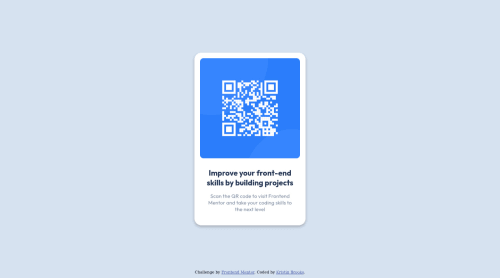QR code component

Solution retrospective
My first time making something like this without a tutorial. Now I just need tons more practice. 😂
Please log in to post a comment
Log in with GitHubCommunity feedback
- @Sdann26
Congratulations on finishing your first frontend mentor project Kristin!
Whenever you finish a challenge I always recommend that you review the bug report that frontend mentor generates because it helps you fix bugs that may be more difficult to detect in the future. In your case we see that you have some accessibility errors that can be easily fixed by doing the following:
- Change
<div class="qr-component">to<main class="qr-component">. - Change
<div class="attribution">to<footer class="attribution">. - Change
<p class="text-lg">to<h1 class="text-lg">.
In the first two cases these are landmark tags that serve to encompass large sections of the project. You should always have a main with the main flow of the project while the footer is more for the bottom section of the projects that usually have one or another detail like links to social networks, the disclaimer, some navigation links, etc.
By the way you should always have a single h1 at first instance you will see that the title of the page should not be the title of the card because it works as a component that will be repeated on several occasions but if you change it will serve you so that at least in this project will not give you any accessibility problem.
And that's all I hope my comment can help you, my pleasure!
- Change
- @nigelvidaaal
Job well done, Kristin! Can I ask what exactly did you do for this project to be so accurate? (like the dimensions and sizes), thanks in advance!
- P@sabbircoder07
Well Done. Best Wishes For You.
Join our Discord community
Join thousands of Frontend Mentor community members taking the challenges, sharing resources, helping each other, and chatting about all things front-end!
Join our Discord